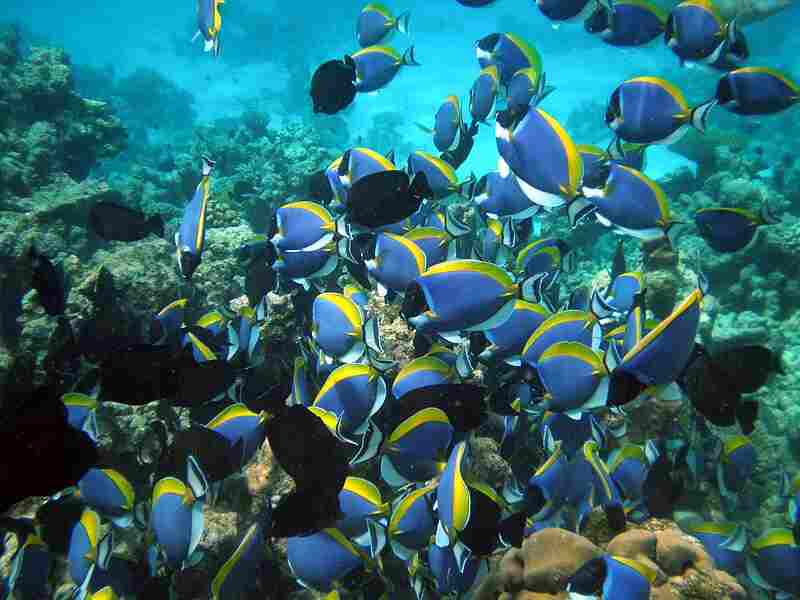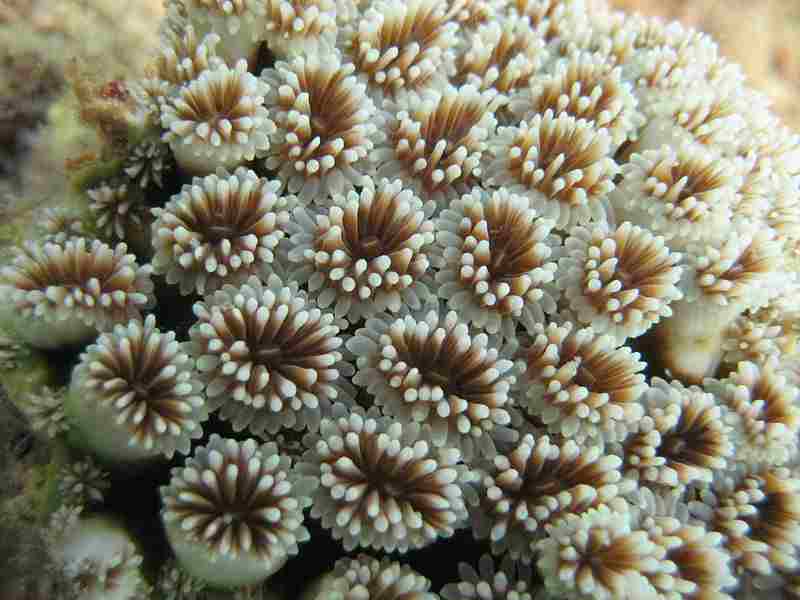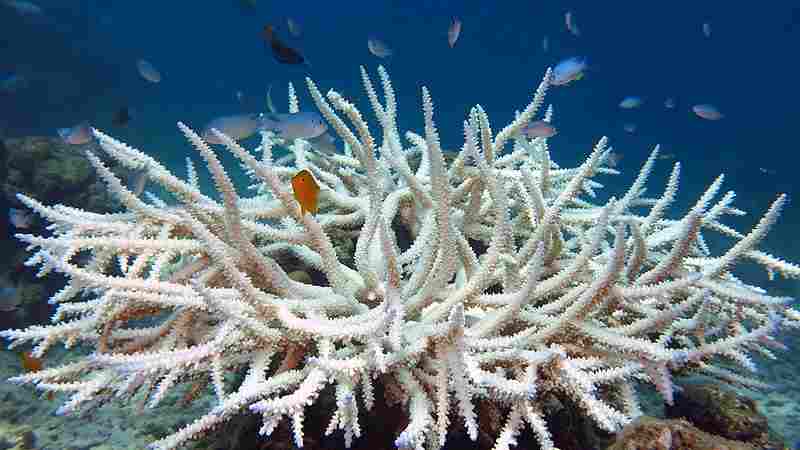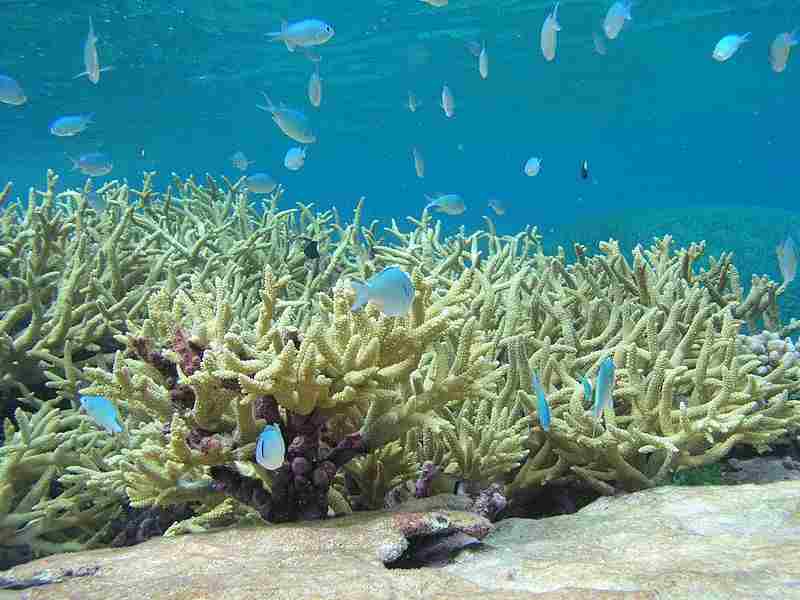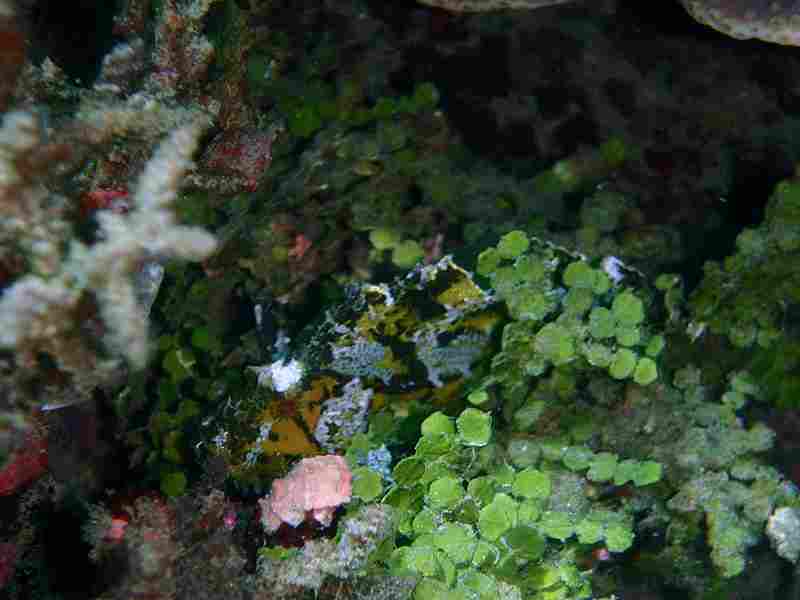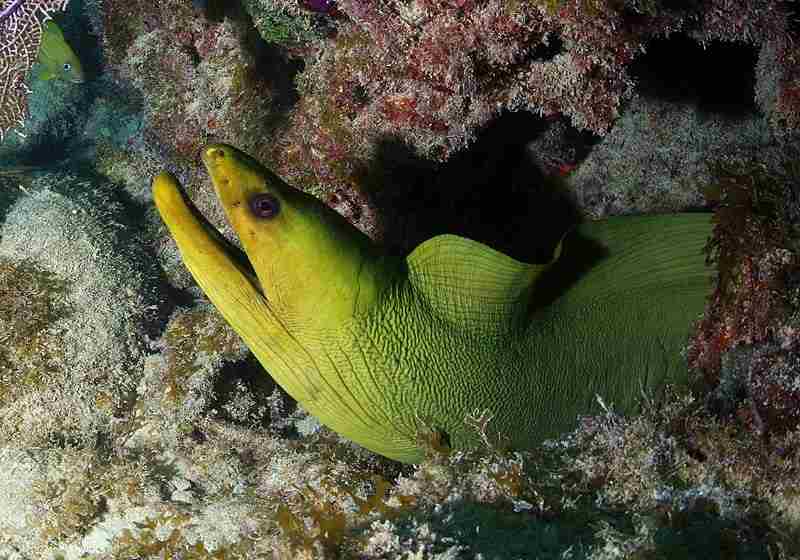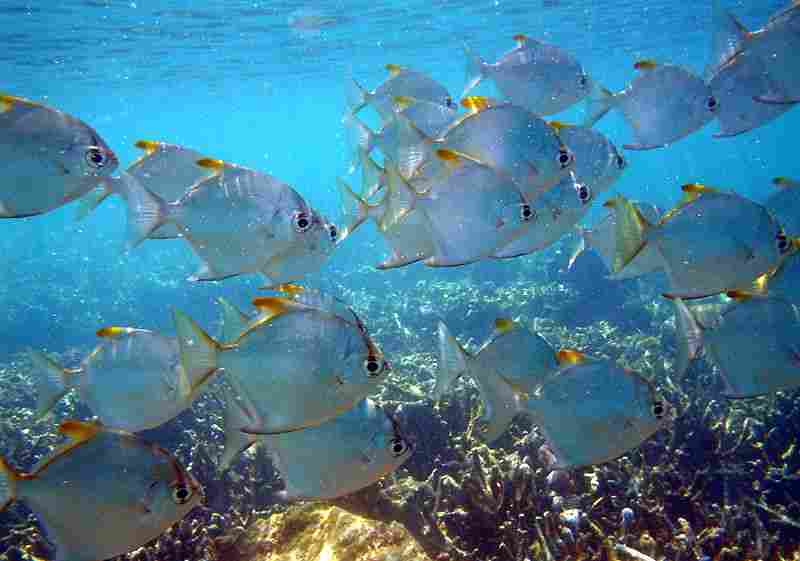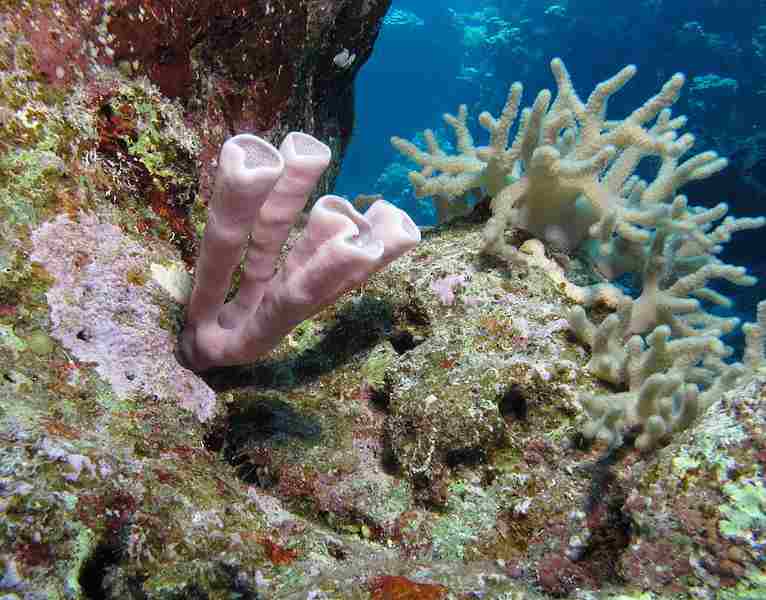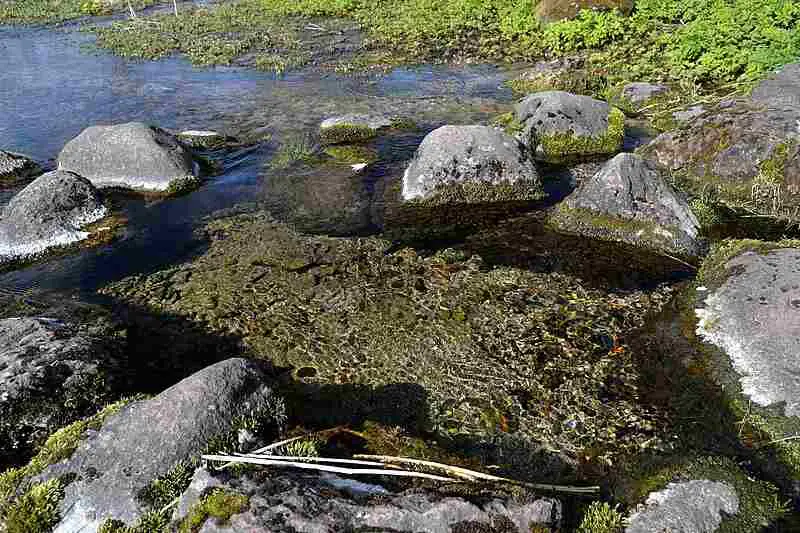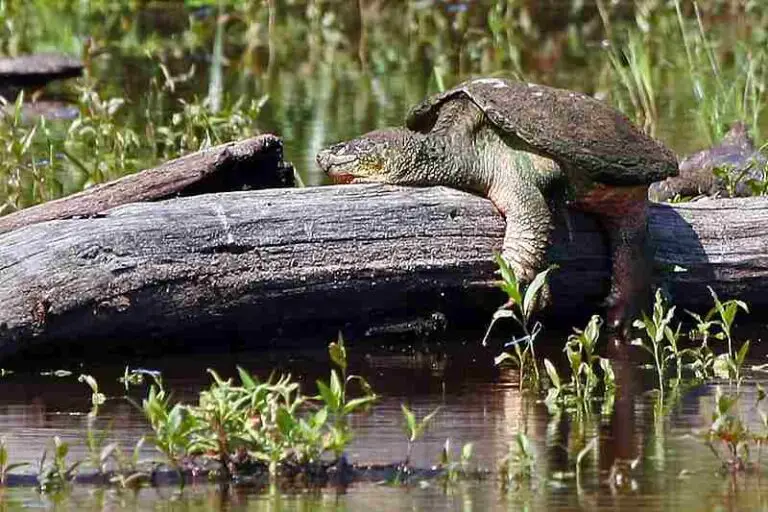9 Abiotic Factors in the Great Barrier Reef and Their Characteristics
Abiotic factors in the Great Barrier Reef are; sunlight, water, carbonate substrate, rock fragments, dissolved gases, nutrients, physicochemical parameters, geochemical processes/cycles, loose sediments and suspended particles.
This article discusses abiotic factors in the Great Barrier Reef and their characteristics, as follows;
1). Sunlight (as one of the Abiotic Factors in the Great Barrier Reef)
Solar radiation in the form of visible light, plays a vital role in the Great Barrier Reef ecosystem.
It is an essential resource for the growth and survival of photosynthetic organisms like macroalgae, seagrasses, and coral-zooxanthellae; which are primary producers in the reef food chain [2].
These producers capture and utilize sunlight to produce chemical bioenergy through photosynthesis, thereby establishing the foundation of the food chain.
How Sunlight Affects Coral Reefs like the Great Barrier Reef Ecosystem
Sunlight affects coral reefs by providing the energy required for sustenance of the symbiotic assemblage, of coral and zooxanthellae (which are photosynthetic algae inhabiting the tissues of coral polyps).
The energy from sunlight, which is supplied to the coral symbiont-colonies, allows corals to acquire nutrients, and build calcium carbonate structures [11].
This implies that sunlight contributes significantly to the formation, continued growth, modification and sustainability, of the intricate coral formations which constitute the Great Barrier Reef.

Effect of Solar Thermal Radiation/Sunlight on Temperature in the Reef Ecosystem
Sunlight regulates the temperature of water in the reef, and influences species richness, distribution, as well as various ecological processes.
Exposure to excessive sunlight, especially when it coincides with periods of high sea temperatures, can result in coral bleaching [1], which is capable of disrupting the balance of the entire reef ecosystem.
Summary on the Role of Sunlight as an Abiotic Factor in the Great Barrier Reef Ecosystem
In summary, sunlight is an essential form of energy for the health and productivity of the Great Barrier Reef, because it supports primary production, and sustains symbiosis, both of which are crucial to overall ecological balance.
It may however have negative effects when supplied with excessive intensity, leading to thermal-buildup; heating, nutrient imbalances, and coral bleaching, among others.
2). Water
Water is one of the most essential abiotic factors in the Great Barrier Reef ecosystem.
This is because it serves as an ambient medium, and provides a habitat for diverse marine animals while supporting various ecological processes.
The conditions and characteristics of water, such as its temperature and compositional quality, have direct impact on the functioning and health of the reef [5].
Characteristics and Parameters of Water in the Reef Ecosystem
Important variables that can be used to evaluate water conditions in the reef ecosystem are; salinity, temperature, clarity, nutrients, flow-trend, and pH. It must be noted that these are also physicochemical parameters, which collectively constitute an abiotic factor in the Great Barrier Reef.
Each of them is briefly discussed below;
*Salinity
Survival of reef organisms depends on stable conditions that feature the right balance of salinity.
Changes in the salinity of water in the Great Barrier Reef, can affect the abundance and distribution of organisms, especially because several of these organisms have adapted to a specific salinity range [12].

*Temperature of Water in the Great Barrier Reef
Water temperature also influences biotic factors in the Great Barrier Reef, and determines the trend of processes like reproduction, growth and biodegradation.
High temperatures can result in coral bleaching; which is a stress response that can cause disruption of the ecosystem, and death of corals.
*Water Clarity in the Great Barrier Reef
Clear water allows sunlight to penetrate to greater depths within the reef environment, which in turn supports coral growth and regional photosynthesis [6].
Sedimentary input from land can reduce water clarity, and may impact coral health negatively.
*Nutrients
Water contains essential nutrients that are needed for the growth of seagrasses, algae, and coral-zooxanthellae; which are all primary food sources for other organisms in the food chain
Excessive input of nutrients as a result of nearby human activities, can result in overgrown algal blooms, which can reduce the survivability and growth of corals among other organisms, thereby disrupting ecological balance. This condition also increases susceptibility of corals to bleaching [4].
*Water Flow-Trend
Water currents help in the dispersal of oxygen and nutrients, as well as other materials that support the resilience and connectivity of the reef ecosystem.
*pH Levels in the Great Barrier Reef
Water pH influences the ability of marine organisms to build and maintain calcium carbonate structures, such as individual shells, and coral reefs.
Ocean acidification, which is caused by excessive carbon dioxide in the atmosphere that infiltrates the water body [7], can decrease the levels of pH and negatively affect calcification and coral growth.
Summary on Water as an Abiotic Factor in the Great Barrier Reef
In summary, water conditions, characteristics and quality all influence the biodiversity and health of the Great Barrier Reef.
Proper conservation and management efforts are important to protect this delicate biome from the effects of pollution, climate change, and other environmental impacts of human activities that can reduce water quality and hinder the long-term survival of the reef itself.
3). Carbonate Substrate (as one of the Abiotic Factors in the Great Barrier Reef)
Carbonate substrate is an important inorganic component, that is essential to the sustenance and evolution of coral reefs in the Great Barrier Reef system.
Corals depend on carbonate ions (CO3^2-) from surrounding water to build their calcium carbonate skeletal structures [3].
These carbonate ions are usually combined with calcium ions (Ca^2+) to produce calcium carbonate, the main material that constitutes coral reefs.
The process of calcification, including the extraction of calcium and carbonate ions from seawater by reef-building organisms like corals; is important for structural development, maintenance and growth of the Great Barrier Reef.
Coral reefs are composed mainly of calcium carbonate, which may accumulate over time as calcifying organisms like corals deposit their rigid calcareous structures on the seabed.
Summary on the Importance of Carbonate Substrate in the Great Barrier Reef
Carbonate substrate is essential as a primary constituent in the evolution and growth of coral reef structures, which make up the Great Barrier Reef system.
Inadequate supply of carbonate ions in the water will reduce the ability of corals to build as well as maintain their intricate structures, so that these structures (and the entire reef) may become vulnerable to degradation.
4). Rock Fragments
Rock fragments are also among the abiotic factors in the Great Barrier Reef ecosystem.
These fragments have a crucial role to play in providing bottom substrate for nutrient recycling and carbon sequestration, and may also serve as microhabitat for some benthic organisms in the reef environment.
Rock fragments in the Great Barrier Reef come from various sources within and beyond their immediate environment. They may be products of weathering and erosion of parent material from other regions of the ocean floor, and may even be derived from adjacent onshore zones.
However, the main rock type from which fragments are derived, in the Great Barrier Reef is limestone or carbonate rock. This is because coral reef structures are themselves made up of calcium carbonate.
The coral reef is primarily composed of limestone, which is a sedimentary rock with calcium carbonate as its main mineralogical constituent [13].
This calcium carbonate is contained in the exoskeletons of calcifying organisms like coral polyps that inhabit the reef environment. Over time, these calcium carbonate deposits accumulate and lithify to form the rigid structure known as the coral reef.

5). Dissolved Gases (as one of the Abiotic Factors in the Great Barrier Reef)
Dissolved gases, especially carbon dioxide and oxygen, play an important role in the Great Barrier Reef ecosystem.
Oxygen is required for respiration of marine organisms, while carbon dioxide is essential for photosynthesis by reef producers like zooxanthellae and macroalgae.
6). Nutrients
Nutrients are very essential for the health and growth of organisms in the Great Barrier Reef.
The most important nutrients in the reef ecosystem include iron, nitrogen, carbon, hydrogen, oxygen and phosphorus.
These nutrients support the growth of primary producers like algae, and sustain trophic relationships that form the foundation of the ecosystem.
Sources of Nutrients to the Great Barrier Reef Ecosystem
Sources of nutrients to Great Barrier Reef are numerous, and include natural processes such as rock weathering and ocean current flow/dispersal; as well as anthropogenic processes like coastal modification and agricultural runoff.
Abiotic Factors that Determine the Health of Coral Reefs
In order to stay healthy, coral reefs depend on specific abiotic conditions, which include; optimal water clarity, oxygenation, stable water temperatures, and appropriate levels of pH and salinity.
Nutrient balance is also very important to the health of the coral reef.
Excessively-high nutrient levels can result in algal overgrowth and coral inhibition, while deficiency on nutrients can limit the growth of primary producers that constitute the foundation of the reef food web [9].
7). Physicochemical Parameters (as one of the Abiotic Factors in the Great Barrier Reef
Physicochemical parameters are abiotic factors that define the physical and chemical conditions as well as composition, of any ecosystem or environment.
The physicochemical parameters in the Great Barrier Reef are;
1. Salinity
2. Temperature
3. pH
4. Nutrient Concentration
5. Dissolved Oxygen (DO)
6. Turbidity
7. Light Intensity
8. Biological Oxygen Demand (BOD)
9. Chemical Oxygen Demand (COD)
Main Abiotic Factor that Determines the Location of a Coral Reef
The main abiotic factor that determines the location of a coral reef is temperature; because it directly affects the survival of corals, and the efficiency of calcification.
Corals generally thrive in warm tropical waters with temperatures between 23°C and 29°C (73°F and 84°F), which is a requisite condition for their survival and growth.
Other abiotic factors that determine the location of coral reefs are; salinity, nutrients and light intensity.
Biotic Factors Involved in Reef Development and Maintenance
Biotic factors that play roles in the development and maintenance of coral reefs include;
1. The presence and photosynthetic activities of symbiotic algae (zooxanthellae)
2. Grazing herbivores that regulate algae growth
3. Abundance, distribution and behavior(s) of predatory organisms
Some geological factors also influence the coral reef's sustainability, such as; suitability of depth, substrate stability, and regional wave processes.
Cause of the 2016 Bleaching Event on the Great Barrier Reef
The cause of the 2016 bleaching event on the Great Barrier Reef was elevated sea temperatures and prolonged, intense heat stress which caused extensive mortality of coral polyps and symbiotic zooxanthellae [10].
Over 30% of the entire reef system was affected, with at least 20% coral mortality. This event exemplifies the critical importance of physicochemical parameters and abiotic factors in general, to the sustenance of reef ecosystems.

Summary on Physicochemical Parameters, and How Biotic and Abiotic Factors Influence the Great Barrier Reef
Both abiotic and biotic factors influence the development and location of coral reefs.
Abiotic factors here include; light availability/intensity, water temperature, substrate, and water depth.
Biotic factors include; symbiotic algae, photosynthetic activity, and the presence of herbivorous and carnivorous consumers.
8). Geochemical Processes and Cycles
Geochemical processes and cycles in the Great Barrier Reef ecosystem, are the dynamic interactions occurring physical constituents of the reef environment, and various chemical elements, also within the environment.
Examples of Geochemical Processes and Cycles in the Great Barrier Reef
Some typical examples of geochemical processes and cycles in the Great Barrier Reef are; oxygen and carbon dioxide exchange, carbonate ion-cycling, and general nutrient cycling. Each of them is discussed briefly below;
*Oxygen and Carbon Dioxide Exchange
Photosynthesis by primary producers (like algae and seagrasses) supports the oxygen cycle by producing oxygen.
On the other hand, respiration by reef organisms consumes oxygen and produces carbon dioxide. This cyclic geochemical dynamic influences the productivity and health of the reef.
*Carbonate Ion-Cycling
Corals in the Great Barrier Reef, build their calcium carbonate exoskeletons using dissolved carbonate ions in seawater.
This process, referred to as calcification, signifies the cycling of carbonate, and is essential for both reef formation and continuous coral growth.
*General Nutrient Cycling
Nutrients like phosphorus and nitrogen, play important roles to support the growth of primary producers like algae, which serve as fuel for the entire food chain/energy pyramid in the reef ecosystem.
Summary on the Importance of Geochemical Processes and Cycles to the Great Barrier Reef
The importance of geochemical processes and cycles to the sustenance of reef ecosystems, can be attributed to the role of these abiotic factors in creating a healthy and balanced environment.
Calcium carbonate deposition by corals, helps build the reef structure, and provides habitats for diverse reef-dwelling marine species.
Nutrient cycling is necessary for primary production, which sustains the entire food chain.
Oxygen and carbon dioxide exchange are important for the survival of reef organisms, including fish, corals and other invertebrates.
The proper functioning of geochemical processes is therefore vital for ecologic resilience and long-term health of reefs.
9). Loose Sediments and Suspended Particles (as Abiotic Factors in the Great Barrier Reef)
Loose sediments and suspended particles in the Great Barrier Reef, are sedimentary abiotic factors, that have both ecological relevance and measurable impact on the inorganic and organic aspects of the ecosystem.
Ecologic Relevance of Loose Sediments and Suspended Particles in the Great Barrier Reef
The ecologic relevance of loose sediments and suspended particles in the Great Barrier Reef can be assessed in terms of; sediment transport, and nutrient-cycling. Each of these is briefly highlighted below;
*Sediment Transport
Loose sediments are vital to processes of sediment transport that occur in coastal areas adjacent to the Great Barrier Reef.
These sediments are involved in the development and maintenance of sandy beaches, regional mangrove habitats, and seagrass beds; which are all essential to the life cycles of various marine species.

*Nutrient Cycling
Suspended particles may facilitate the transport of nutrients (like nitrogen and phosphorus) that are needed by primary producers like seagrasses and algae, so that they play a role in the overall productivity of the reef.
Impacts of Loose Sediments and Suspended Particles on Biotic and Abiotic Components of The Great Barrier Reef
The impacts of loose sediments and suspended particles on the Great Barrier Reef ecosystem can be analyzed in terms of coral health, habitat alteration/modification, light availability, water quality and species distribution. They are each briefly discussed below;
*Coral Health
Excessive sedimentary dispersal can inhibit coral polyps, and reduce their ability to obtain nutrients, or carry out photosynthesis. This condition can also facilitate events like coral bleaching, heat stress, and mortality of polyps (alongside other reef species).
*Habitat Alteration/Modification
Sediments can alter the physical structure and chemical/mineralogical composition of habitats within the Great Barrier Reef zone, such as individual coral reefs and seagrass beds.
This can in turn affect the availability of shelter and other essential resources for various species.
*Light Availability
Suspended particles can intercept light rays and reduce their penetration into the water, so that the rate of photosynthesis for coral polyps and other photosynthetic organisms, is affected.
*Water Quality
High sediment loads can cause degradation of water quality in the Great Barrier Reef [8], and may impact the health of marine life, including invertebrates and fish.
*Species Distribution
The distribution of marine species is often influenced by the presence, concentration and dispersal of suspended particles, as some organisms may avoid areas with high concentration of suspended particles (that is; areas with high turbidity).
Conclusion
Abiotic factors in the Great Barrier Reef are;
1. Sunlight
2. Water
3. Carbonate Substrate
4. Rock Fragments
5. Dissolved Gases
6. Nutrients
7. Physicochemical Parameters
8. Geochemical Processes and Cycles
9. Loose Sediments and Suspended Particles
References
1). Brown, B. E.; Dunne, R. P. (2015). "Coral Bleaching: The Roles of Sea Temperature and Solar Radiation." Available at: https://doi.org/10.1002/9781118828502.ch18. (Accessed 20 July 2023).
2). Carreon-Palau, L.; Parrish, C. C.; España, H. P.; Aguíñiga-García, S. (2018). "Elemental ratios and lipid classes in a coral reef food web under river influence." Progress In Oceanography 164. Available at: https://doi.org/10.1016/j.pocean.2018.03.009. (Accessed 20 July 2023).
3). Cohen, A. L.; Michael, H. (2009). "Why Corals Care About Ocean Acidification: Uncovering the Mechanism." Oceanography (Washington D.C.) 22(4). Available at: https://doi.org/10.5670/oceanog.2009.102. (Accessed 20 July 2023).
4). D'Angelo, C.; Wiedenmann, J. (2014). "Impacts of nutrient enrichment on coral reefs: New perspectives and implications for coastal management and reef survival." Current Opinion in Environmental Sustainability 7:82–93. Available at: https://doi.org/10.1016/j.cosust.2013.11.029. (Accessed 20 July 2023).
5). Ding, D.-S.; Patel, A. K.; Singhania, R. R.; Chen, C.-W.; Dong, C.-D. (2022). "Effects of Temperature and Salinity on Growth, Metabolism and Digestive Enzymes Synthesis of Goniopora columna." Biology 11(3):436. Available at: https://doi.org/10.3390/biology11030436. (Accessed 20 July 2023).
6). Fabricius, K.; Logan, M.; Weeks, S. J.; Brodie, J. E. (2014). "The effects of river run-off on water clarity across the central Great Barrier Reef." Marine Pollution Bulletin 84(1-2). Available at: https://doi.org/10.1016/j.marpolbul.2014.05.012. (Accessed 20 July 2023).
7). Godbold, J. A.; Calosi, P. (2013). "Ocean acidification and climate change: Advances in ecology and evolution." The Royal Society, Philosophical Transactions of The Royal Society B Biological Sciences 368(1627):20120448. Available at: https://doi.org/10.1098/rstb.2012.0448. (Accessed 20 July 2023).
8). Jahanbakht, M.; Xiang, W.; Azghadi, M. R. (2022). "Sediment Prediction in the Great Barrier Reef using Vision Transformer with finite element analysis." Neural networks: the official journal of the International Neural Network Society 152(2). Available at: https://doi.org/10.1016/j.neunet.2022.04.022. (Accessed 20 July 2023)
9). Larned, S. (1998). "Nitrogen-versus phosphorus-limited growth and sources of nutrients for coral reef macroalgae." Marine Biology 132(3):409-421. Available at: https://doi.org/10.1007/s002270050407. (Accessed 20 July 2023).
10). Ng, C. S. L.; Huang, D.; Toh, K. B.; Sam, S. Q.; Kikuzawa, Y. P.; Toh, T. C.; Taira, D.; Chan, Y. K. S.; Hung, L. Z. T.; Sim, W. T.; Rashid, A. R.; Afiq-Rosli, L.; Ng, N. K.; Chou, L. M. (2020). "Responses of urban reef corals during the 2016 mass bleaching event." Marine Pollution Bulletin 154:111111. Available at: https://doi.org/10.1016/j.marpolbul.2020.111111. (Accessed 20 July 2023).
11). Putnam, H. M.; Barott, K. L.; Ainsworth, T. D.; Gates, R. D. (2017). "The Vulnerability and Resilience of Reef-Building Corals." Curr Biol. 2017 Jun 5;27(11):R528-R540. Available at: https://doi.org/10.1016/j.cub.2017.04.047. (Accessed 20 July 2023).
12). Smyth, K.; Elliott, M. (2016). "Effects of changing salinity on the ecology of the marine environment." Stressors in the Marine Environment. Available at: https://doi.org/10.1093/acprof:oso/9780198718826.003.0009. (Accessed 20 July 2023).
13). Zhong, Y.; Li, Q.; Wang, R.; Yao, T. (2022). "Changes of Physical and Mechanical Properties of Coral Reef Limestone under CO2–Seawater–Rock Interaction." Appl. Sci. 2022, 12, 4105. Available at: https://doi.org/10.3390/app12094105. (Accessed 20 July 2023).
